Does Marijuana have a Medicinal Value?
VerifiedAdded on 2023/04/08
|12
|2685
|396
AI Summary
This paper examines the ongoing debate on the medicinal benefits of marijuana and its potential legalization. It discusses the source methodology, research results, and differences between scholarly and popular sources. The topic relates to the course themes of necessity as the mother of invention and management and control.
Contribute Materials
Your contribution can guide someone’s learning journey. Share your
documents today.
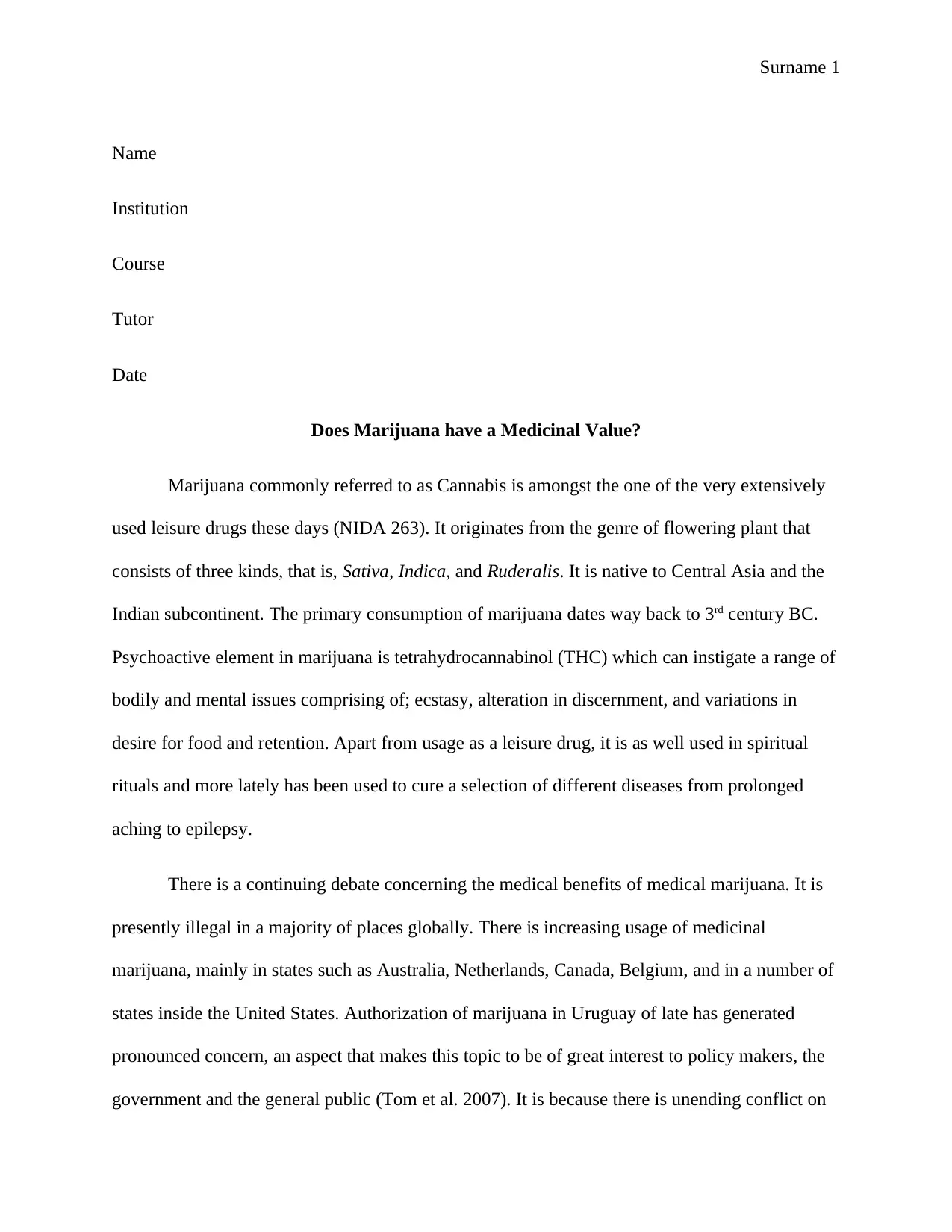
Surname 1
Name
Institution
Course
Tutor
Date
Does Marijuana have a Medicinal Value?
Marijuana commonly referred to as Cannabis is amongst the one of the very extensively
used leisure drugs these days (NIDA 263). It originates from the genre of flowering plant that
consists of three kinds, that is, Sativa, Indica, and Ruderalis. It is native to Central Asia and the
Indian subcontinent. The primary consumption of marijuana dates way back to 3rd century BC.
Psychoactive element in marijuana is tetrahydrocannabinol (THC) which can instigate a range of
bodily and mental issues comprising of; ecstasy, alteration in discernment, and variations in
desire for food and retention. Apart from usage as a leisure drug, it is as well used in spiritual
rituals and more lately has been used to cure a selection of different diseases from prolonged
aching to epilepsy.
There is a continuing debate concerning the medical benefits of medical marijuana. It is
presently illegal in a majority of places globally. There is increasing usage of medicinal
marijuana, mainly in states such as Australia, Netherlands, Canada, Belgium, and in a number of
states inside the United States. Authorization of marijuana in Uruguay of late has generated
pronounced concern, an aspect that makes this topic to be of great interest to policy makers, the
government and the general public (Tom et al. 2007). It is because there is unending conflict on
Name
Institution
Course
Tutor
Date
Does Marijuana have a Medicinal Value?
Marijuana commonly referred to as Cannabis is amongst the one of the very extensively
used leisure drugs these days (NIDA 263). It originates from the genre of flowering plant that
consists of three kinds, that is, Sativa, Indica, and Ruderalis. It is native to Central Asia and the
Indian subcontinent. The primary consumption of marijuana dates way back to 3rd century BC.
Psychoactive element in marijuana is tetrahydrocannabinol (THC) which can instigate a range of
bodily and mental issues comprising of; ecstasy, alteration in discernment, and variations in
desire for food and retention. Apart from usage as a leisure drug, it is as well used in spiritual
rituals and more lately has been used to cure a selection of different diseases from prolonged
aching to epilepsy.
There is a continuing debate concerning the medical benefits of medical marijuana. It is
presently illegal in a majority of places globally. There is increasing usage of medicinal
marijuana, mainly in states such as Australia, Netherlands, Canada, Belgium, and in a number of
states inside the United States. Authorization of marijuana in Uruguay of late has generated
pronounced concern, an aspect that makes this topic to be of great interest to policy makers, the
government and the general public (Tom et al. 2007). It is because there is unending conflict on
Secure Best Marks with AI Grader
Need help grading? Try our AI Grader for instant feedback on your assignments.
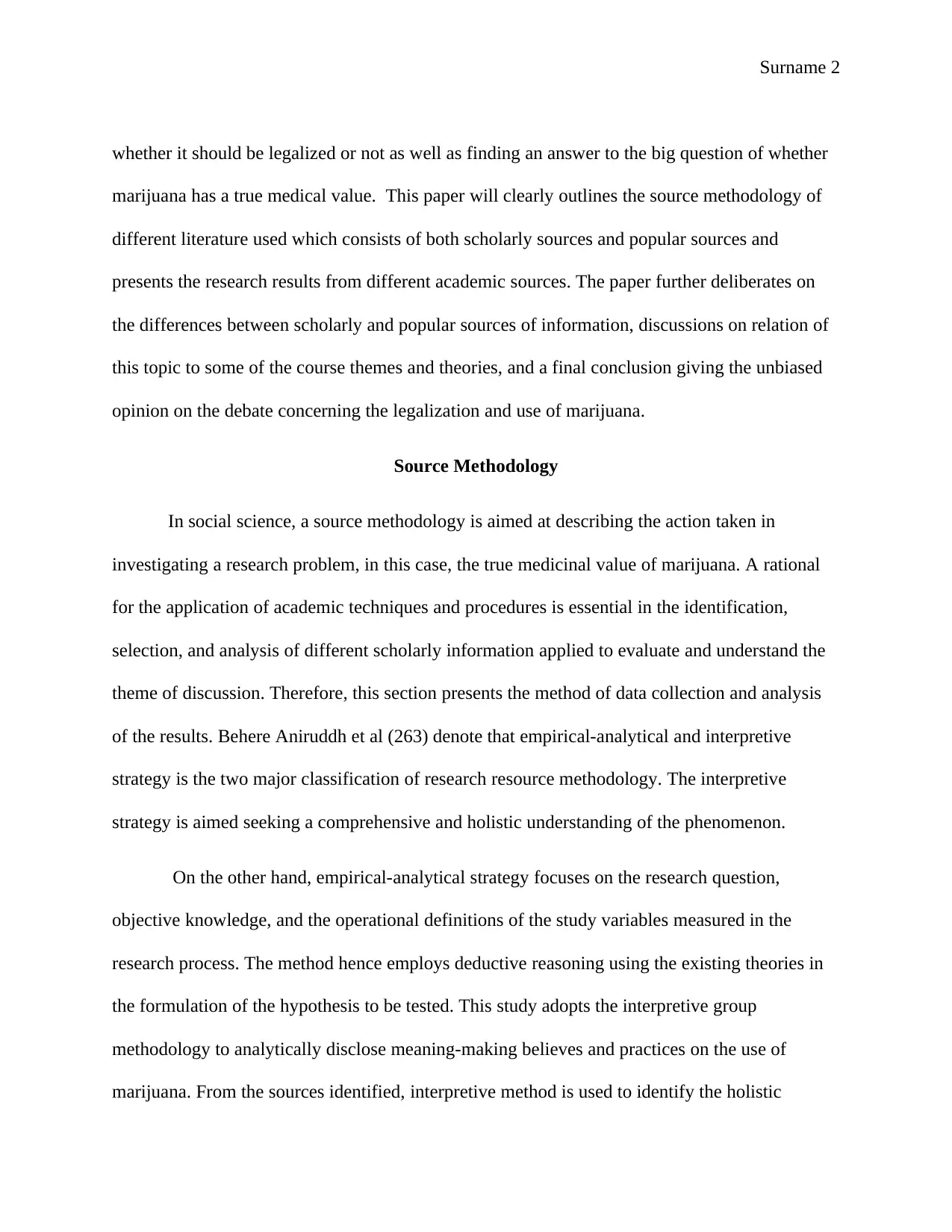
Surname 2
whether it should be legalized or not as well as finding an answer to the big question of whether
marijuana has a true medical value. This paper will clearly outlines the source methodology of
different literature used which consists of both scholarly sources and popular sources and
presents the research results from different academic sources. The paper further deliberates on
the differences between scholarly and popular sources of information, discussions on relation of
this topic to some of the course themes and theories, and a final conclusion giving the unbiased
opinion on the debate concerning the legalization and use of marijuana.
Source Methodology
In social science, a source methodology is aimed at describing the action taken in
investigating a research problem, in this case, the true medicinal value of marijuana. A rational
for the application of academic techniques and procedures is essential in the identification,
selection, and analysis of different scholarly information applied to evaluate and understand the
theme of discussion. Therefore, this section presents the method of data collection and analysis
of the results. Behere Aniruddh et al (263) denote that empirical-analytical and interpretive
strategy is the two major classification of research resource methodology. The interpretive
strategy is aimed seeking a comprehensive and holistic understanding of the phenomenon.
On the other hand, empirical-analytical strategy focuses on the research question,
objective knowledge, and the operational definitions of the study variables measured in the
research process. The method hence employs deductive reasoning using the existing theories in
the formulation of the hypothesis to be tested. This study adopts the interpretive group
methodology to analytically disclose meaning-making believes and practices on the use of
marijuana. From the sources identified, interpretive method is used to identify the holistic
whether it should be legalized or not as well as finding an answer to the big question of whether
marijuana has a true medical value. This paper will clearly outlines the source methodology of
different literature used which consists of both scholarly sources and popular sources and
presents the research results from different academic sources. The paper further deliberates on
the differences between scholarly and popular sources of information, discussions on relation of
this topic to some of the course themes and theories, and a final conclusion giving the unbiased
opinion on the debate concerning the legalization and use of marijuana.
Source Methodology
In social science, a source methodology is aimed at describing the action taken in
investigating a research problem, in this case, the true medicinal value of marijuana. A rational
for the application of academic techniques and procedures is essential in the identification,
selection, and analysis of different scholarly information applied to evaluate and understand the
theme of discussion. Therefore, this section presents the method of data collection and analysis
of the results. Behere Aniruddh et al (263) denote that empirical-analytical and interpretive
strategy is the two major classification of research resource methodology. The interpretive
strategy is aimed seeking a comprehensive and holistic understanding of the phenomenon.
On the other hand, empirical-analytical strategy focuses on the research question,
objective knowledge, and the operational definitions of the study variables measured in the
research process. The method hence employs deductive reasoning using the existing theories in
the formulation of the hypothesis to be tested. This study adopts the interpretive group
methodology to analytically disclose meaning-making believes and practices on the use of
marijuana. From the sources identified, interpretive method is used to identify the holistic
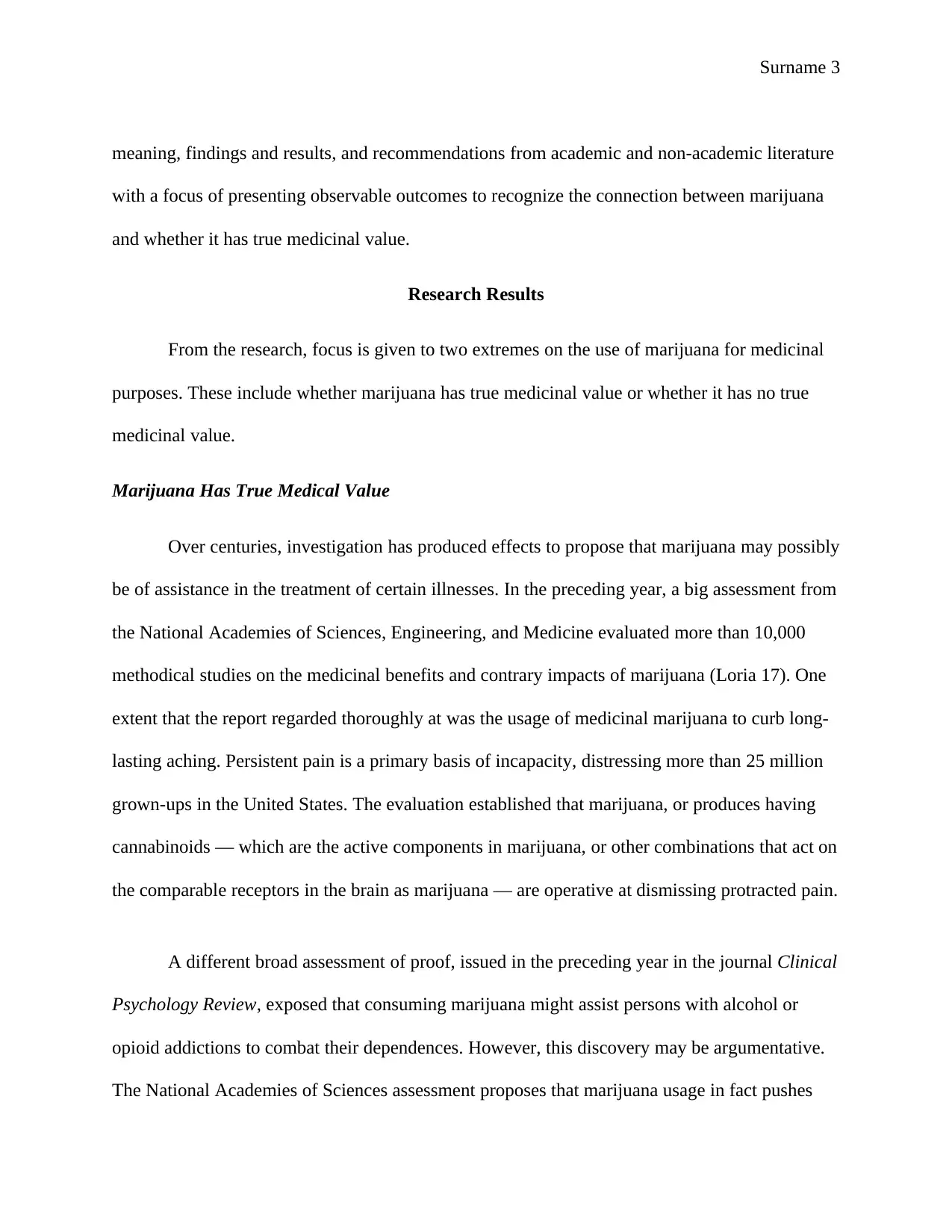
Surname 3
meaning, findings and results, and recommendations from academic and non-academic literature
with a focus of presenting observable outcomes to recognize the connection between marijuana
and whether it has true medicinal value.
Research Results
From the research, focus is given to two extremes on the use of marijuana for medicinal
purposes. These include whether marijuana has true medicinal value or whether it has no true
medicinal value.
Marijuana Has True Medical Value
Over centuries, investigation has produced effects to propose that marijuana may possibly
be of assistance in the treatment of certain illnesses. In the preceding year, a big assessment from
the National Academies of Sciences, Engineering, and Medicine evaluated more than 10,000
methodical studies on the medicinal benefits and contrary impacts of marijuana (Loria 17). One
extent that the report regarded thoroughly at was the usage of medicinal marijuana to curb long-
lasting aching. Persistent pain is a primary basis of incapacity, distressing more than 25 million
grown-ups in the United States. The evaluation established that marijuana, or produces having
cannabinoids — which are the active components in marijuana, or other combinations that act on
the comparable receptors in the brain as marijuana — are operative at dismissing protracted pain.
A different broad assessment of proof, issued in the preceding year in the journal Clinical
Psychology Review, exposed that consuming marijuana might assist persons with alcohol or
opioid addictions to combat their dependences. However, this discovery may be argumentative.
The National Academies of Sciences assessment proposes that marijuana usage in fact pushes
meaning, findings and results, and recommendations from academic and non-academic literature
with a focus of presenting observable outcomes to recognize the connection between marijuana
and whether it has true medicinal value.
Research Results
From the research, focus is given to two extremes on the use of marijuana for medicinal
purposes. These include whether marijuana has true medicinal value or whether it has no true
medicinal value.
Marijuana Has True Medical Value
Over centuries, investigation has produced effects to propose that marijuana may possibly
be of assistance in the treatment of certain illnesses. In the preceding year, a big assessment from
the National Academies of Sciences, Engineering, and Medicine evaluated more than 10,000
methodical studies on the medicinal benefits and contrary impacts of marijuana (Loria 17). One
extent that the report regarded thoroughly at was the usage of medicinal marijuana to curb long-
lasting aching. Persistent pain is a primary basis of incapacity, distressing more than 25 million
grown-ups in the United States. The evaluation established that marijuana, or produces having
cannabinoids — which are the active components in marijuana, or other combinations that act on
the comparable receptors in the brain as marijuana — are operative at dismissing protracted pain.
A different broad assessment of proof, issued in the preceding year in the journal Clinical
Psychology Review, exposed that consuming marijuana might assist persons with alcohol or
opioid addictions to combat their dependences. However, this discovery may be argumentative.
The National Academies of Sciences assessment proposes that marijuana usage in fact pushes
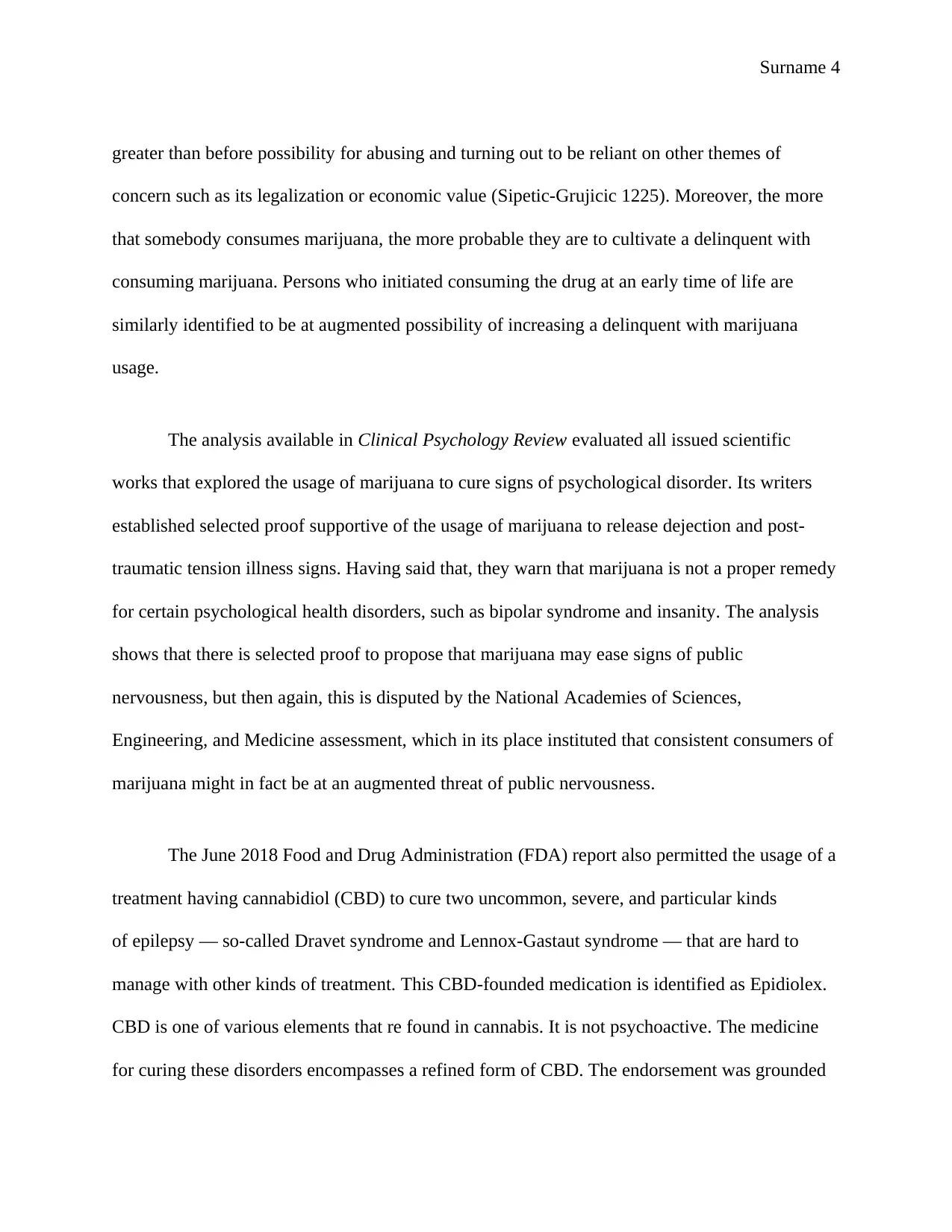
Surname 4
greater than before possibility for abusing and turning out to be reliant on other themes of
concern such as its legalization or economic value (Sipetic-Grujicic 1225). Moreover, the more
that somebody consumes marijuana, the more probable they are to cultivate a delinquent with
consuming marijuana. Persons who initiated consuming the drug at an early time of life are
similarly identified to be at augmented possibility of increasing a delinquent with marijuana
usage.
The analysis available in Clinical Psychology Review evaluated all issued scientific
works that explored the usage of marijuana to cure signs of psychological disorder. Its writers
established selected proof supportive of the usage of marijuana to release dejection and post-
traumatic tension illness signs. Having said that, they warn that marijuana is not a proper remedy
for certain psychological health disorders, such as bipolar syndrome and insanity. The analysis
shows that there is selected proof to propose that marijuana may ease signs of public
nervousness, but then again, this is disputed by the National Academies of Sciences,
Engineering, and Medicine assessment, which in its place instituted that consistent consumers of
marijuana might in fact be at an augmented threat of public nervousness.
The June 2018 Food and Drug Administration (FDA) report also permitted the usage of a
treatment having cannabidiol (CBD) to cure two uncommon, severe, and particular kinds
of epilepsy — so-called Dravet syndrome and Lennox-Gastaut syndrome — that are hard to
manage with other kinds of treatment. This CBD-founded medication is identified as Epidiolex.
CBD is one of various elements that re found in cannabis. It is not psychoactive. The medicine
for curing these disorders encompasses a refined form of CBD. The endorsement was grounded
greater than before possibility for abusing and turning out to be reliant on other themes of
concern such as its legalization or economic value (Sipetic-Grujicic 1225). Moreover, the more
that somebody consumes marijuana, the more probable they are to cultivate a delinquent with
consuming marijuana. Persons who initiated consuming the drug at an early time of life are
similarly identified to be at augmented possibility of increasing a delinquent with marijuana
usage.
The analysis available in Clinical Psychology Review evaluated all issued scientific
works that explored the usage of marijuana to cure signs of psychological disorder. Its writers
established selected proof supportive of the usage of marijuana to release dejection and post-
traumatic tension illness signs. Having said that, they warn that marijuana is not a proper remedy
for certain psychological health disorders, such as bipolar syndrome and insanity. The analysis
shows that there is selected proof to propose that marijuana may ease signs of public
nervousness, but then again, this is disputed by the National Academies of Sciences,
Engineering, and Medicine assessment, which in its place instituted that consistent consumers of
marijuana might in fact be at an augmented threat of public nervousness.
The June 2018 Food and Drug Administration (FDA) report also permitted the usage of a
treatment having cannabidiol (CBD) to cure two uncommon, severe, and particular kinds
of epilepsy — so-called Dravet syndrome and Lennox-Gastaut syndrome — that are hard to
manage with other kinds of treatment. This CBD-founded medication is identified as Epidiolex.
CBD is one of various elements that re found in cannabis. It is not psychoactive. The medicine
for curing these disorders encompasses a refined form of CBD. The endorsement was grounded
Secure Best Marks with AI Grader
Need help grading? Try our AI Grader for instant feedback on your assignments.
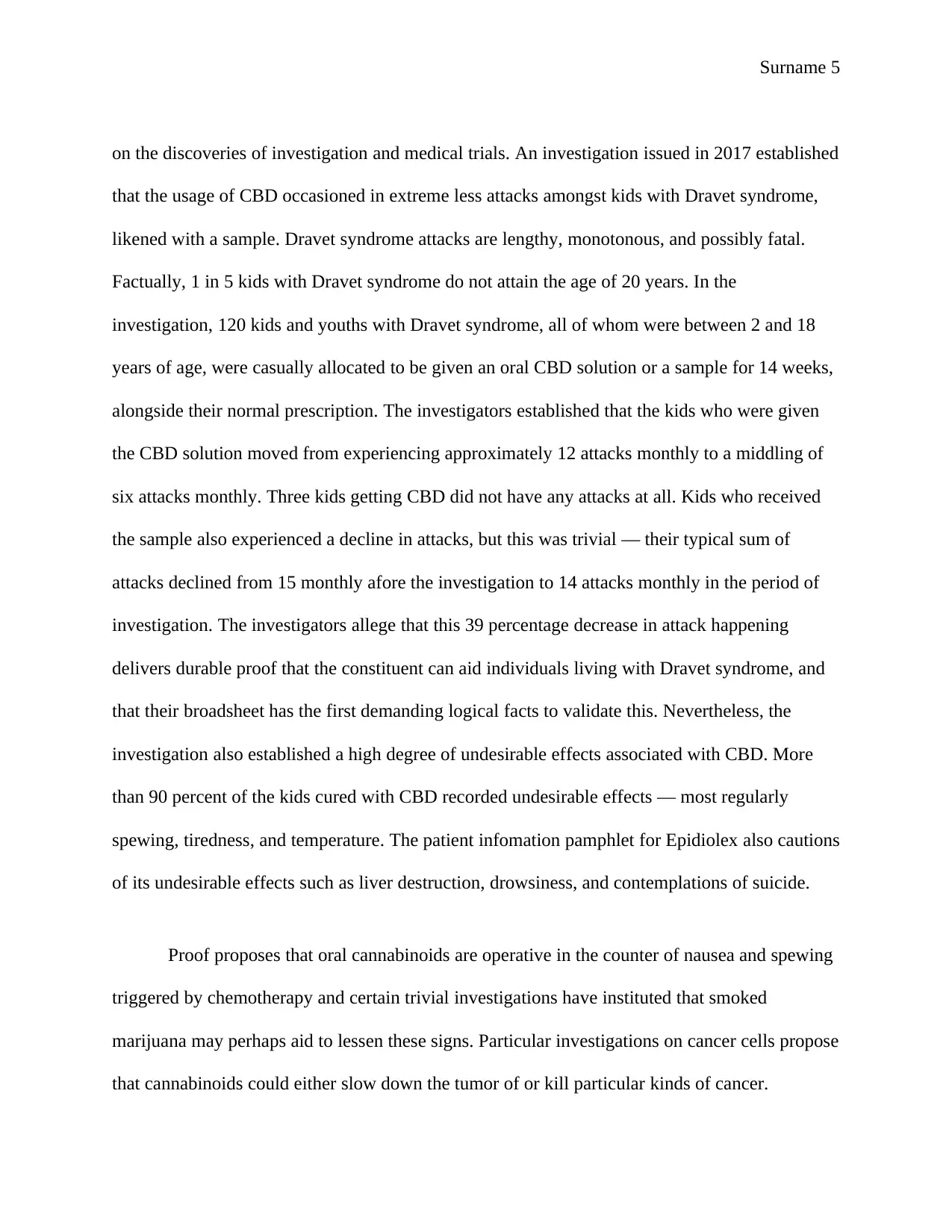
Surname 5
on the discoveries of investigation and medical trials. An investigation issued in 2017 established
that the usage of CBD occasioned in extreme less attacks amongst kids with Dravet syndrome,
likened with a sample. Dravet syndrome attacks are lengthy, monotonous, and possibly fatal.
Factually, 1 in 5 kids with Dravet syndrome do not attain the age of 20 years. In the
investigation, 120 kids and youths with Dravet syndrome, all of whom were between 2 and 18
years of age, were casually allocated to be given an oral CBD solution or a sample for 14 weeks,
alongside their normal prescription. The investigators established that the kids who were given
the CBD solution moved from experiencing approximately 12 attacks monthly to a middling of
six attacks monthly. Three kids getting CBD did not have any attacks at all. Kids who received
the sample also experienced a decline in attacks, but this was trivial — their typical sum of
attacks declined from 15 monthly afore the investigation to 14 attacks monthly in the period of
investigation. The investigators allege that this 39 percentage decrease in attack happening
delivers durable proof that the constituent can aid individuals living with Dravet syndrome, and
that their broadsheet has the first demanding logical facts to validate this. Nevertheless, the
investigation also established a high degree of undesirable effects associated with CBD. More
than 90 percent of the kids cured with CBD recorded undesirable effects — most regularly
spewing, tiredness, and temperature. The patient infomation pamphlet for Epidiolex also cautions
of its undesirable effects such as liver destruction, drowsiness, and contemplations of suicide.
Proof proposes that oral cannabinoids are operative in the counter of nausea and spewing
triggered by chemotherapy and certain trivial investigations have instituted that smoked
marijuana may perhaps aid to lessen these signs. Particular investigations on cancer cells propose
that cannabinoids could either slow down the tumor of or kill particular kinds of cancer.
on the discoveries of investigation and medical trials. An investigation issued in 2017 established
that the usage of CBD occasioned in extreme less attacks amongst kids with Dravet syndrome,
likened with a sample. Dravet syndrome attacks are lengthy, monotonous, and possibly fatal.
Factually, 1 in 5 kids with Dravet syndrome do not attain the age of 20 years. In the
investigation, 120 kids and youths with Dravet syndrome, all of whom were between 2 and 18
years of age, were casually allocated to be given an oral CBD solution or a sample for 14 weeks,
alongside their normal prescription. The investigators established that the kids who were given
the CBD solution moved from experiencing approximately 12 attacks monthly to a middling of
six attacks monthly. Three kids getting CBD did not have any attacks at all. Kids who received
the sample also experienced a decline in attacks, but this was trivial — their typical sum of
attacks declined from 15 monthly afore the investigation to 14 attacks monthly in the period of
investigation. The investigators allege that this 39 percentage decrease in attack happening
delivers durable proof that the constituent can aid individuals living with Dravet syndrome, and
that their broadsheet has the first demanding logical facts to validate this. Nevertheless, the
investigation also established a high degree of undesirable effects associated with CBD. More
than 90 percent of the kids cured with CBD recorded undesirable effects — most regularly
spewing, tiredness, and temperature. The patient infomation pamphlet for Epidiolex also cautions
of its undesirable effects such as liver destruction, drowsiness, and contemplations of suicide.
Proof proposes that oral cannabinoids are operative in the counter of nausea and spewing
triggered by chemotherapy and certain trivial investigations have instituted that smoked
marijuana may perhaps aid to lessen these signs. Particular investigations on cancer cells propose
that cannabinoids could either slow down the tumor of or kill particular kinds of cancer.
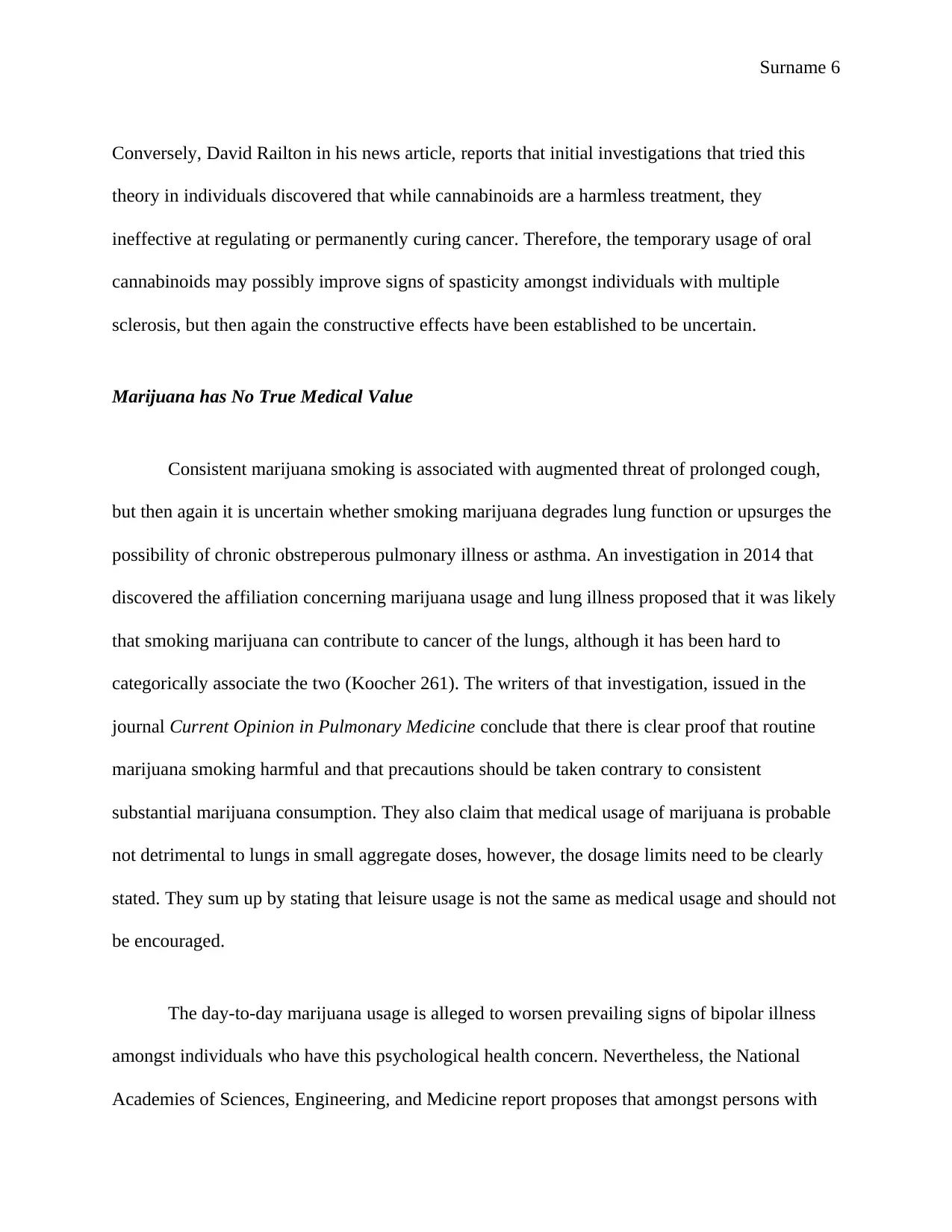
Surname 6
Conversely, David Railton in his news article, reports that initial investigations that tried this
theory in individuals discovered that while cannabinoids are a harmless treatment, they
ineffective at regulating or permanently curing cancer. Therefore, the temporary usage of oral
cannabinoids may possibly improve signs of spasticity amongst individuals with multiple
sclerosis, but then again the constructive effects have been established to be uncertain.
Marijuana has No True Medical Value
Consistent marijuana smoking is associated with augmented threat of prolonged cough,
but then again it is uncertain whether smoking marijuana degrades lung function or upsurges the
possibility of chronic obstreperous pulmonary illness or asthma. An investigation in 2014 that
discovered the affiliation concerning marijuana usage and lung illness proposed that it was likely
that smoking marijuana can contribute to cancer of the lungs, although it has been hard to
categorically associate the two (Koocher 261). The writers of that investigation, issued in the
journal Current Opinion in Pulmonary Medicine conclude that there is clear proof that routine
marijuana smoking harmful and that precautions should be taken contrary to consistent
substantial marijuana consumption. They also claim that medical usage of marijuana is probable
not detrimental to lungs in small aggregate doses, however, the dosage limits need to be clearly
stated. They sum up by stating that leisure usage is not the same as medical usage and should not
be encouraged.
The day-to-day marijuana usage is alleged to worsen prevailing signs of bipolar illness
amongst individuals who have this psychological health concern. Nevertheless, the National
Academies of Sciences, Engineering, and Medicine report proposes that amongst persons with
Conversely, David Railton in his news article, reports that initial investigations that tried this
theory in individuals discovered that while cannabinoids are a harmless treatment, they
ineffective at regulating or permanently curing cancer. Therefore, the temporary usage of oral
cannabinoids may possibly improve signs of spasticity amongst individuals with multiple
sclerosis, but then again the constructive effects have been established to be uncertain.
Marijuana has No True Medical Value
Consistent marijuana smoking is associated with augmented threat of prolonged cough,
but then again it is uncertain whether smoking marijuana degrades lung function or upsurges the
possibility of chronic obstreperous pulmonary illness or asthma. An investigation in 2014 that
discovered the affiliation concerning marijuana usage and lung illness proposed that it was likely
that smoking marijuana can contribute to cancer of the lungs, although it has been hard to
categorically associate the two (Koocher 261). The writers of that investigation, issued in the
journal Current Opinion in Pulmonary Medicine conclude that there is clear proof that routine
marijuana smoking harmful and that precautions should be taken contrary to consistent
substantial marijuana consumption. They also claim that medical usage of marijuana is probable
not detrimental to lungs in small aggregate doses, however, the dosage limits need to be clearly
stated. They sum up by stating that leisure usage is not the same as medical usage and should not
be encouraged.
The day-to-day marijuana usage is alleged to worsen prevailing signs of bipolar illness
amongst individuals who have this psychological health concern. Nevertheless, the National
Academies of Sciences, Engineering, and Medicine report proposes that amongst persons with
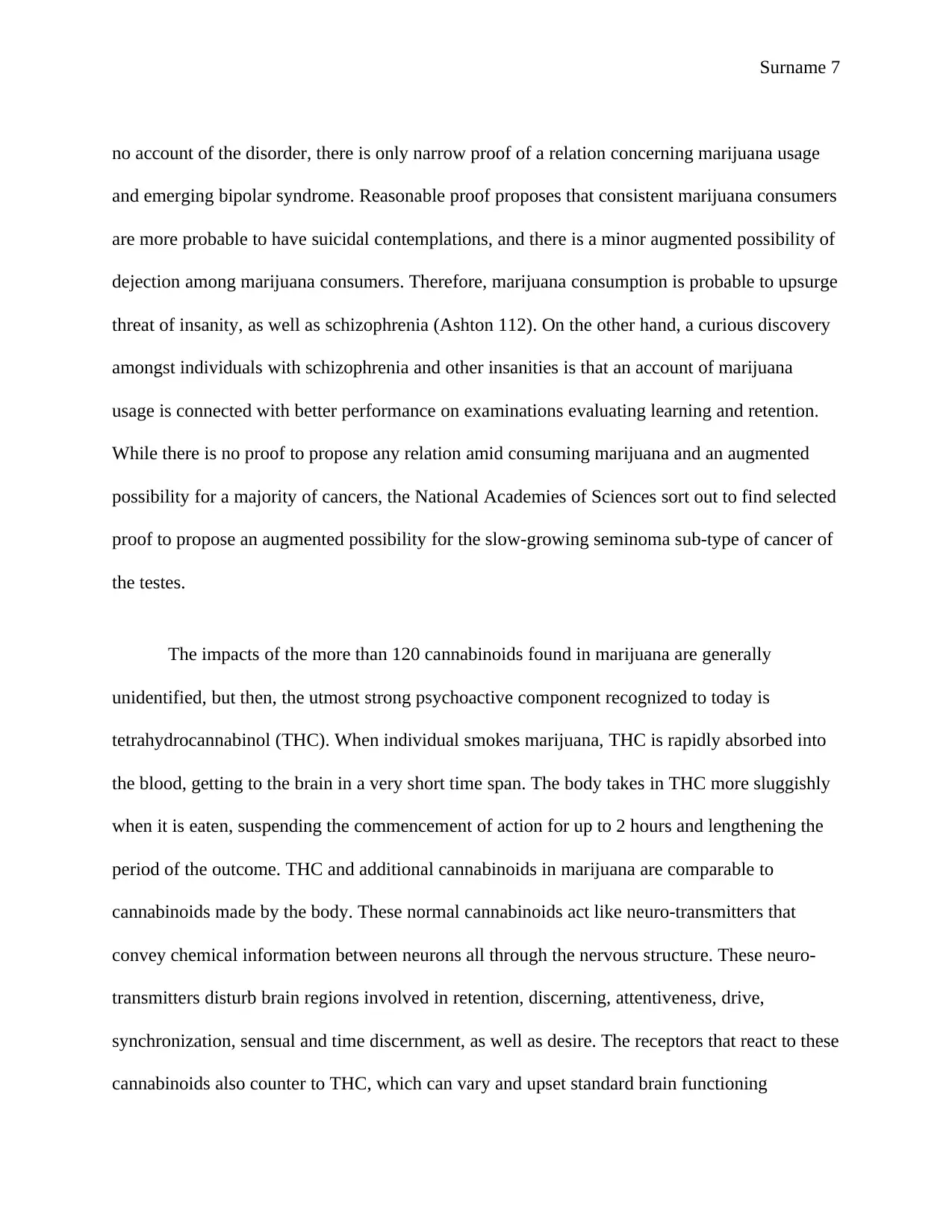
Surname 7
no account of the disorder, there is only narrow proof of a relation concerning marijuana usage
and emerging bipolar syndrome. Reasonable proof proposes that consistent marijuana consumers
are more probable to have suicidal contemplations, and there is a minor augmented possibility of
dejection among marijuana consumers. Therefore, marijuana consumption is probable to upsurge
threat of insanity, as well as schizophrenia (Ashton 112). On the other hand, a curious discovery
amongst individuals with schizophrenia and other insanities is that an account of marijuana
usage is connected with better performance on examinations evaluating learning and retention.
While there is no proof to propose any relation amid consuming marijuana and an augmented
possibility for a majority of cancers, the National Academies of Sciences sort out to find selected
proof to propose an augmented possibility for the slow-growing seminoma sub-type of cancer of
the testes.
The impacts of the more than 120 cannabinoids found in marijuana are generally
unidentified, but then, the utmost strong psychoactive component recognized to today is
tetrahydrocannabinol (THC). When individual smokes marijuana, THC is rapidly absorbed into
the blood, getting to the brain in a very short time span. The body takes in THC more sluggishly
when it is eaten, suspending the commencement of action for up to 2 hours and lengthening the
period of the outcome. THC and additional cannabinoids in marijuana are comparable to
cannabinoids made by the body. These normal cannabinoids act like neuro-transmitters that
convey chemical information between neurons all through the nervous structure. These neuro-
transmitters disturb brain regions involved in retention, discerning, attentiveness, drive,
synchronization, sensual and time discernment, as well as desire. The receptors that react to these
cannabinoids also counter to THC, which can vary and upset standard brain functioning
no account of the disorder, there is only narrow proof of a relation concerning marijuana usage
and emerging bipolar syndrome. Reasonable proof proposes that consistent marijuana consumers
are more probable to have suicidal contemplations, and there is a minor augmented possibility of
dejection among marijuana consumers. Therefore, marijuana consumption is probable to upsurge
threat of insanity, as well as schizophrenia (Ashton 112). On the other hand, a curious discovery
amongst individuals with schizophrenia and other insanities is that an account of marijuana
usage is connected with better performance on examinations evaluating learning and retention.
While there is no proof to propose any relation amid consuming marijuana and an augmented
possibility for a majority of cancers, the National Academies of Sciences sort out to find selected
proof to propose an augmented possibility for the slow-growing seminoma sub-type of cancer of
the testes.
The impacts of the more than 120 cannabinoids found in marijuana are generally
unidentified, but then, the utmost strong psychoactive component recognized to today is
tetrahydrocannabinol (THC). When individual smokes marijuana, THC is rapidly absorbed into
the blood, getting to the brain in a very short time span. The body takes in THC more sluggishly
when it is eaten, suspending the commencement of action for up to 2 hours and lengthening the
period of the outcome. THC and additional cannabinoids in marijuana are comparable to
cannabinoids made by the body. These normal cannabinoids act like neuro-transmitters that
convey chemical information between neurons all through the nervous structure. These neuro-
transmitters disturb brain regions involved in retention, discerning, attentiveness, drive,
synchronization, sensual and time discernment, as well as desire. The receptors that react to these
cannabinoids also counter to THC, which can vary and upset standard brain functioning
Paraphrase This Document
Need a fresh take? Get an instant paraphrase of this document with our AI Paraphraser
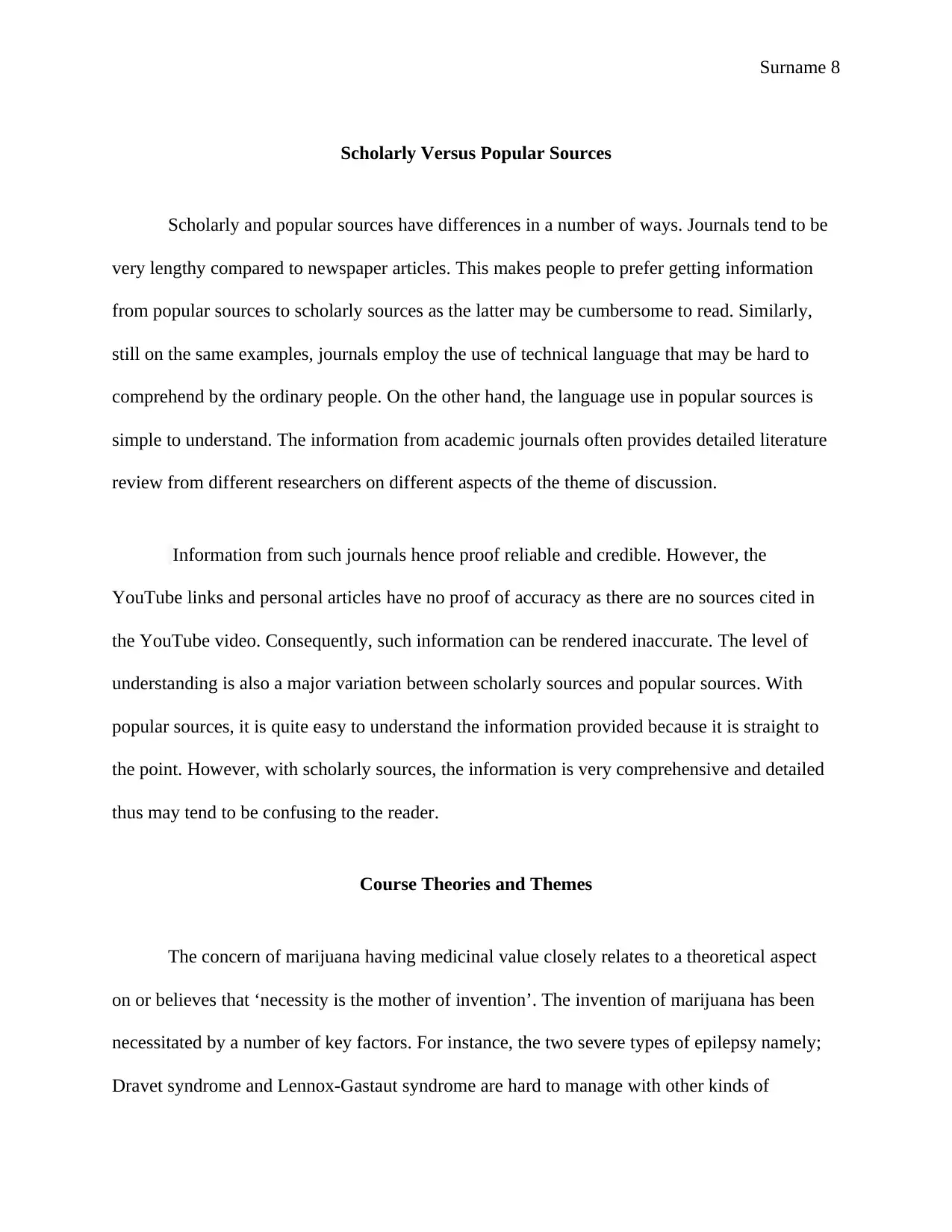
Surname 8
Scholarly Versus Popular Sources
Scholarly and popular sources have differences in a number of ways. Journals tend to be
very lengthy compared to newspaper articles. This makes people to prefer getting information
from popular sources to scholarly sources as the latter may be cumbersome to read. Similarly,
still on the same examples, journals employ the use of technical language that may be hard to
comprehend by the ordinary people. On the other hand, the language use in popular sources is
simple to understand. The information from academic journals often provides detailed literature
review from different researchers on different aspects of the theme of discussion.
Information from such journals hence proof reliable and credible. However, the
YouTube links and personal articles have no proof of accuracy as there are no sources cited in
the YouTube video. Consequently, such information can be rendered inaccurate. The level of
understanding is also a major variation between scholarly sources and popular sources. With
popular sources, it is quite easy to understand the information provided because it is straight to
the point. However, with scholarly sources, the information is very comprehensive and detailed
thus may tend to be confusing to the reader.
Course Theories and Themes
The concern of marijuana having medicinal value closely relates to a theoretical aspect
on or believes that ‘necessity is the mother of invention’. The invention of marijuana has been
necessitated by a number of key factors. For instance, the two severe types of epilepsy namely;
Dravet syndrome and Lennox-Gastaut syndrome are hard to manage with other kinds of
Scholarly Versus Popular Sources
Scholarly and popular sources have differences in a number of ways. Journals tend to be
very lengthy compared to newspaper articles. This makes people to prefer getting information
from popular sources to scholarly sources as the latter may be cumbersome to read. Similarly,
still on the same examples, journals employ the use of technical language that may be hard to
comprehend by the ordinary people. On the other hand, the language use in popular sources is
simple to understand. The information from academic journals often provides detailed literature
review from different researchers on different aspects of the theme of discussion.
Information from such journals hence proof reliable and credible. However, the
YouTube links and personal articles have no proof of accuracy as there are no sources cited in
the YouTube video. Consequently, such information can be rendered inaccurate. The level of
understanding is also a major variation between scholarly sources and popular sources. With
popular sources, it is quite easy to understand the information provided because it is straight to
the point. However, with scholarly sources, the information is very comprehensive and detailed
thus may tend to be confusing to the reader.
Course Theories and Themes
The concern of marijuana having medicinal value closely relates to a theoretical aspect
on or believes that ‘necessity is the mother of invention’. The invention of marijuana has been
necessitated by a number of key factors. For instance, the two severe types of epilepsy namely;
Dravet syndrome and Lennox-Gastaut syndrome are hard to manage with other kinds of
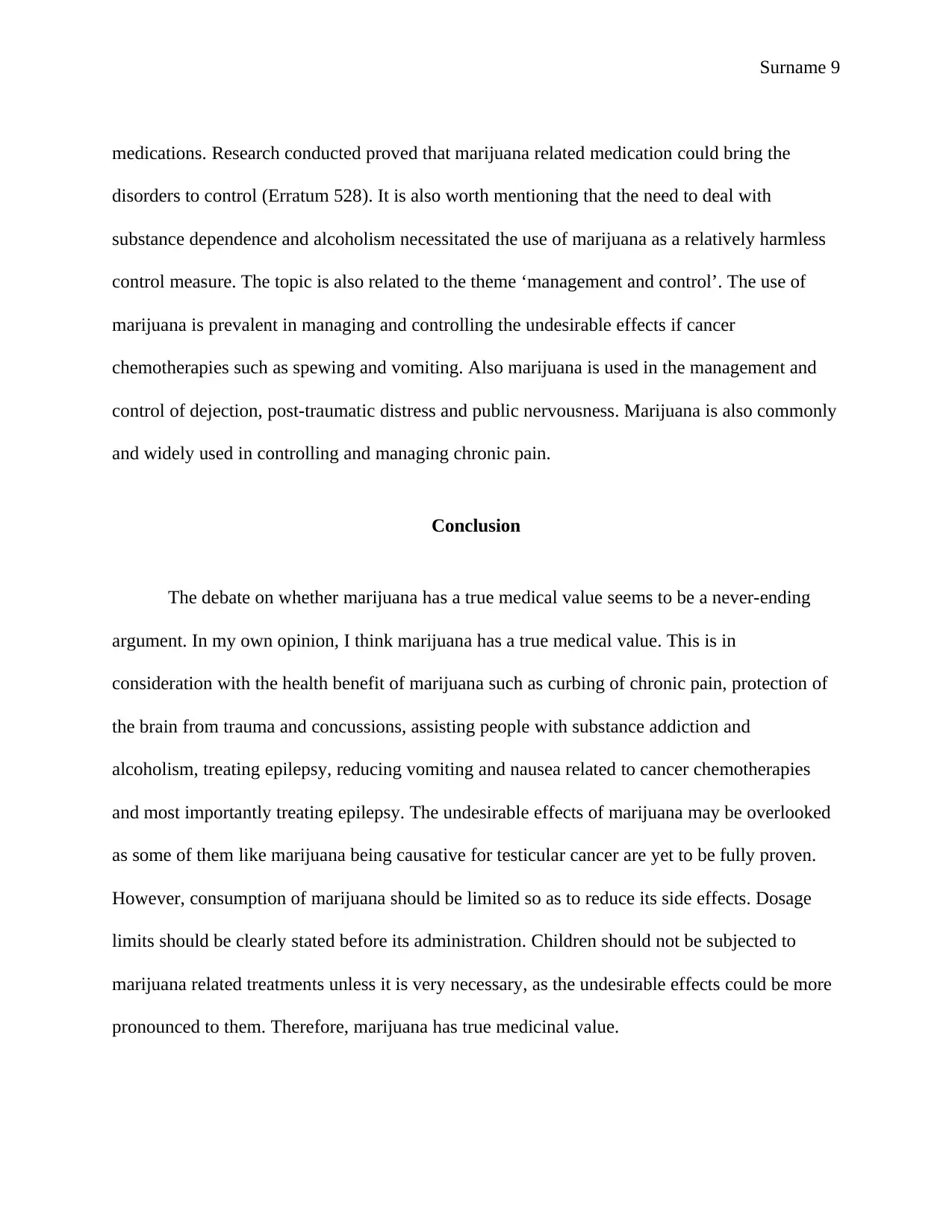
Surname 9
medications. Research conducted proved that marijuana related medication could bring the
disorders to control (Erratum 528). It is also worth mentioning that the need to deal with
substance dependence and alcoholism necessitated the use of marijuana as a relatively harmless
control measure. The topic is also related to the theme ‘management and control’. The use of
marijuana is prevalent in managing and controlling the undesirable effects if cancer
chemotherapies such as spewing and vomiting. Also marijuana is used in the management and
control of dejection, post-traumatic distress and public nervousness. Marijuana is also commonly
and widely used in controlling and managing chronic pain.
Conclusion
The debate on whether marijuana has a true medical value seems to be a never-ending
argument. In my own opinion, I think marijuana has a true medical value. This is in
consideration with the health benefit of marijuana such as curbing of chronic pain, protection of
the brain from trauma and concussions, assisting people with substance addiction and
alcoholism, treating epilepsy, reducing vomiting and nausea related to cancer chemotherapies
and most importantly treating epilepsy. The undesirable effects of marijuana may be overlooked
as some of them like marijuana being causative for testicular cancer are yet to be fully proven.
However, consumption of marijuana should be limited so as to reduce its side effects. Dosage
limits should be clearly stated before its administration. Children should not be subjected to
marijuana related treatments unless it is very necessary, as the undesirable effects could be more
pronounced to them. Therefore, marijuana has true medicinal value.
medications. Research conducted proved that marijuana related medication could bring the
disorders to control (Erratum 528). It is also worth mentioning that the need to deal with
substance dependence and alcoholism necessitated the use of marijuana as a relatively harmless
control measure. The topic is also related to the theme ‘management and control’. The use of
marijuana is prevalent in managing and controlling the undesirable effects if cancer
chemotherapies such as spewing and vomiting. Also marijuana is used in the management and
control of dejection, post-traumatic distress and public nervousness. Marijuana is also commonly
and widely used in controlling and managing chronic pain.
Conclusion
The debate on whether marijuana has a true medical value seems to be a never-ending
argument. In my own opinion, I think marijuana has a true medical value. This is in
consideration with the health benefit of marijuana such as curbing of chronic pain, protection of
the brain from trauma and concussions, assisting people with substance addiction and
alcoholism, treating epilepsy, reducing vomiting and nausea related to cancer chemotherapies
and most importantly treating epilepsy. The undesirable effects of marijuana may be overlooked
as some of them like marijuana being causative for testicular cancer are yet to be fully proven.
However, consumption of marijuana should be limited so as to reduce its side effects. Dosage
limits should be clearly stated before its administration. Children should not be subjected to
marijuana related treatments unless it is very necessary, as the undesirable effects could be more
pronounced to them. Therefore, marijuana has true medicinal value.
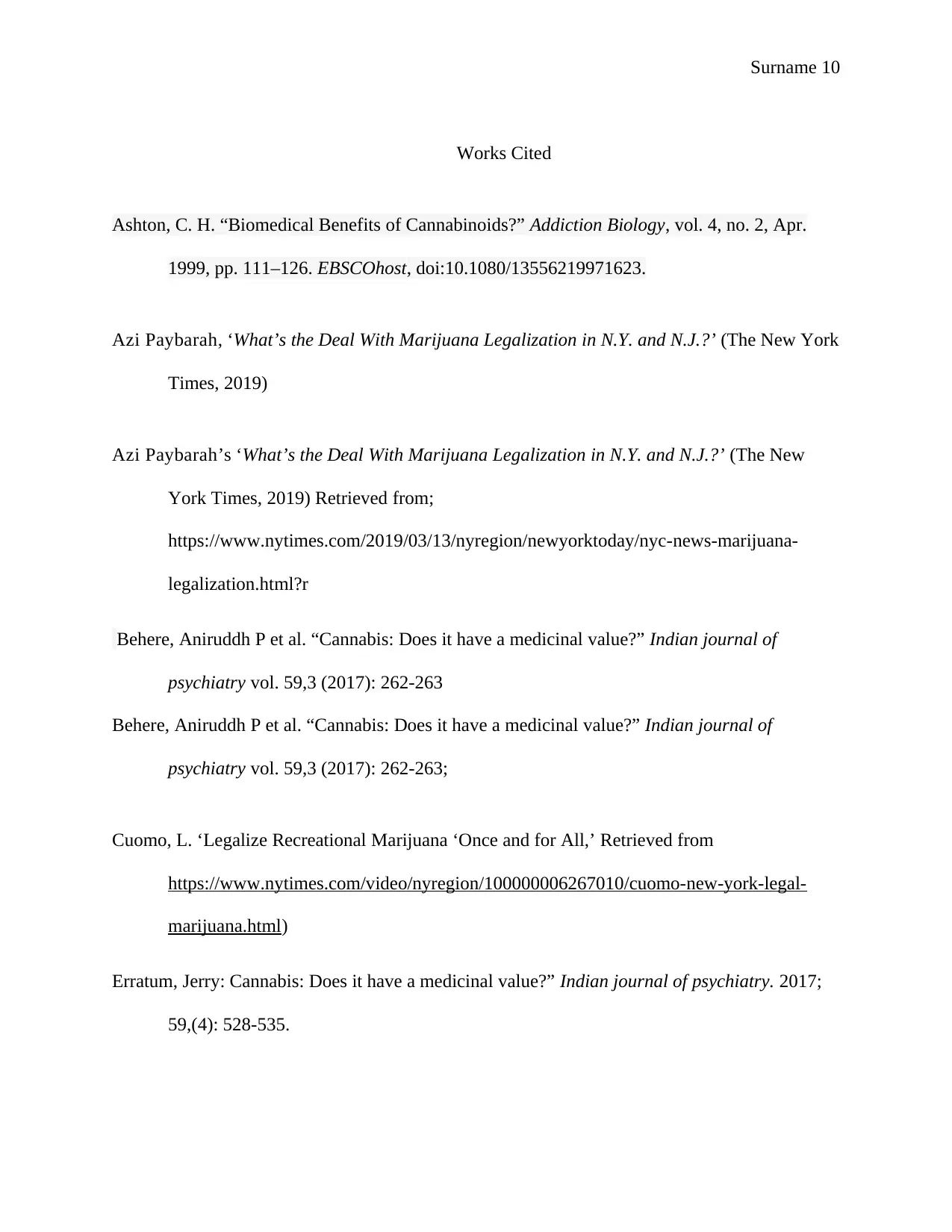
Surname 10
Works Cited
Ashton, C. H. “Biomedical Benefits of Cannabinoids?” Addiction Biology, vol. 4, no. 2, Apr.
1999, pp. 111–126. EBSCOhost, doi:10.1080/13556219971623.
Azi Paybarah, ‘What’s the Deal With Marijuana Legalization in N.Y. and N.J.?’ (The New York
Times, 2019)
Azi Paybarah’s ‘What’s the Deal With Marijuana Legalization in N.Y. and N.J.?’ (The New
York Times, 2019) Retrieved from;
https://www.nytimes.com/2019/03/13/nyregion/newyorktoday/nyc-news-marijuana-
legalization.html?r
Behere, Aniruddh P et al. “Cannabis: Does it have a medicinal value?” Indian journal of
psychiatry vol. 59,3 (2017): 262-263
Behere, Aniruddh P et al. “Cannabis: Does it have a medicinal value?” Indian journal of
psychiatry vol. 59,3 (2017): 262-263;
Cuomo, L. ‘Legalize Recreational Marijuana ‘Once and for All,’ Retrieved from
https://www.nytimes.com/video/nyregion/100000006267010/cuomo-new-york-legal-
marijuana.html)
Erratum, Jerry: Cannabis: Does it have a medicinal value?” Indian journal of psychiatry. 2017;
59,(4): 528-535.
Works Cited
Ashton, C. H. “Biomedical Benefits of Cannabinoids?” Addiction Biology, vol. 4, no. 2, Apr.
1999, pp. 111–126. EBSCOhost, doi:10.1080/13556219971623.
Azi Paybarah, ‘What’s the Deal With Marijuana Legalization in N.Y. and N.J.?’ (The New York
Times, 2019)
Azi Paybarah’s ‘What’s the Deal With Marijuana Legalization in N.Y. and N.J.?’ (The New
York Times, 2019) Retrieved from;
https://www.nytimes.com/2019/03/13/nyregion/newyorktoday/nyc-news-marijuana-
legalization.html?r
Behere, Aniruddh P et al. “Cannabis: Does it have a medicinal value?” Indian journal of
psychiatry vol. 59,3 (2017): 262-263
Behere, Aniruddh P et al. “Cannabis: Does it have a medicinal value?” Indian journal of
psychiatry vol. 59,3 (2017): 262-263;
Cuomo, L. ‘Legalize Recreational Marijuana ‘Once and for All,’ Retrieved from
https://www.nytimes.com/video/nyregion/100000006267010/cuomo-new-york-legal-
marijuana.html)
Erratum, Jerry: Cannabis: Does it have a medicinal value?” Indian journal of psychiatry. 2017;
59,(4): 528-535.
Secure Best Marks with AI Grader
Need help grading? Try our AI Grader for instant feedback on your assignments.
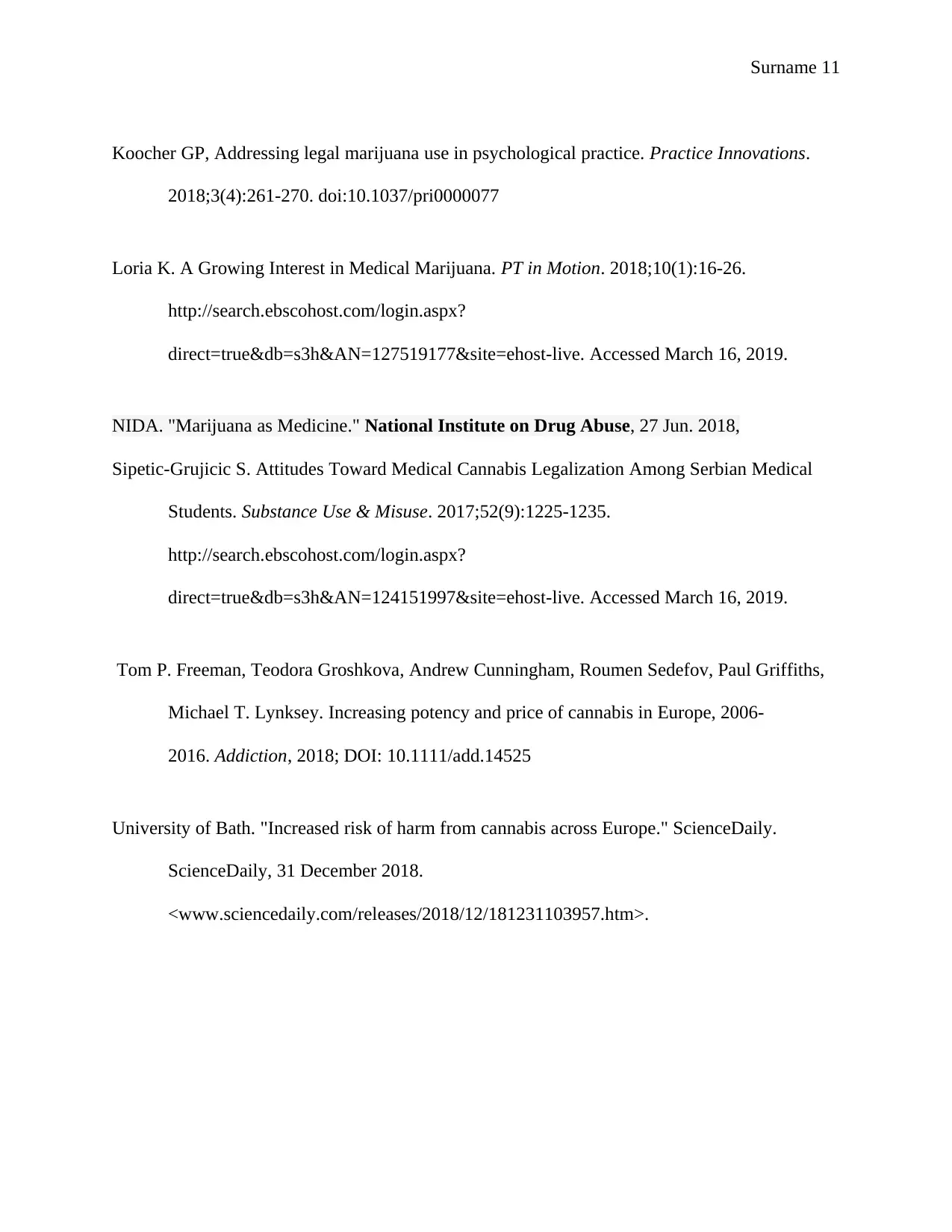
Surname 11
Koocher GP, Addressing legal marijuana use in psychological practice. Practice Innovations.
2018;3(4):261-270. doi:10.1037/pri0000077
Loria K. A Growing Interest in Medical Marijuana. PT in Motion. 2018;10(1):16-26.
http://search.ebscohost.com/login.aspx?
direct=true&db=s3h&AN=127519177&site=ehost-live. Accessed March 16, 2019.
NIDA. "Marijuana as Medicine." National Institute on Drug Abuse, 27 Jun. 2018,
Sipetic-Grujicic S. Attitudes Toward Medical Cannabis Legalization Among Serbian Medical
Students. Substance Use & Misuse. 2017;52(9):1225-1235.
http://search.ebscohost.com/login.aspx?
direct=true&db=s3h&AN=124151997&site=ehost-live. Accessed March 16, 2019.
Tom P. Freeman, Teodora Groshkova, Andrew Cunningham, Roumen Sedefov, Paul Griffiths,
Michael T. Lynksey. Increasing potency and price of cannabis in Europe, 2006-
2016. Addiction, 2018; DOI: 10.1111/add.14525
University of Bath. "Increased risk of harm from cannabis across Europe." ScienceDaily.
ScienceDaily, 31 December 2018.
<www.sciencedaily.com/releases/2018/12/181231103957.htm>.
Koocher GP, Addressing legal marijuana use in psychological practice. Practice Innovations.
2018;3(4):261-270. doi:10.1037/pri0000077
Loria K. A Growing Interest in Medical Marijuana. PT in Motion. 2018;10(1):16-26.
http://search.ebscohost.com/login.aspx?
direct=true&db=s3h&AN=127519177&site=ehost-live. Accessed March 16, 2019.
NIDA. "Marijuana as Medicine." National Institute on Drug Abuse, 27 Jun. 2018,
Sipetic-Grujicic S. Attitudes Toward Medical Cannabis Legalization Among Serbian Medical
Students. Substance Use & Misuse. 2017;52(9):1225-1235.
http://search.ebscohost.com/login.aspx?
direct=true&db=s3h&AN=124151997&site=ehost-live. Accessed March 16, 2019.
Tom P. Freeman, Teodora Groshkova, Andrew Cunningham, Roumen Sedefov, Paul Griffiths,
Michael T. Lynksey. Increasing potency and price of cannabis in Europe, 2006-
2016. Addiction, 2018; DOI: 10.1111/add.14525
University of Bath. "Increased risk of harm from cannabis across Europe." ScienceDaily.
ScienceDaily, 31 December 2018.
<www.sciencedaily.com/releases/2018/12/181231103957.htm>.

Surname 12
1 out of 12
Your All-in-One AI-Powered Toolkit for Academic Success.
+13062052269
info@desklib.com
Available 24*7 on WhatsApp / Email
![[object Object]](/_next/static/media/star-bottom.7253800d.svg)
Unlock your academic potential
© 2024 | Zucol Services PVT LTD | All rights reserved.